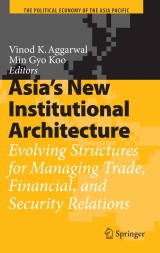Details

Asia's New Institutional Architecture
Evolving Structures for Managing Trade, Financial, and Security RelationsThe Political Economy of the Asia Pacific
|
213,99 € |
|
| Verlag: | Springer |
| Format: | |
| Veröffentl.: | 15.10.2007 |
| ISBN/EAN: | 9783540723899 |
| Sprache: | englisch |
| Anzahl Seiten: | 322 |
Dieses eBook enthält ein Wasserzeichen.
Beschreibungen
Can regional and interregional mechanisms better institutionalize the - creasing complexity of economic and security ties among states in Nor- east, Southeast, and South Asia? As the international state system und- goes dramatic changes in both security and trade relations in the wake of the Cold War’s end, the Asian financial crisis, and the attacks of Sept- ber 11, 2001, this question is now of critical importance to both academics and policymakers. Still, little research has been done to integrate the ana- sis of both regional security and economic dynamics within a broader c- text that will give us theoretically informed policy insights. Indeed, when we began our background research on the origin and e- lution of Asia’s institutional architecture in trade and security, we found that many scholars had focused on individual subregions, whether Nor- east, Southeast or South Asia. In some cases, scholars examined links - tween Northeast and Southeast Asia, and the literature often refers to these two subregions collectively as “Asia”, artificially bracketing South Asia. Of course, we are aware that as products of culture, economics, history, and politics, the boundaries of geographic regions change over time. Yet the rapid rise of India and its increasing links to East Asia (especially those formed in the early 1990s) suggest that it would be fruitful to examine both developments within each subregion as well as links across subregions.
Asia’s New Institutional Architecture: Evolving Structures for Managing Trade, Financial, and Security Relations.- Asia’s New Economic Institutions.- Building Asian Security Institutions Under the Triple Shocks: Competitive, Complementary or Juxtaposed?.- Regional Arrangements for Trade in Northeast Asia: Cooperation and Competition between China and Japan.- Security Institutions in Northeast Asia: Multilateral Responses to Structural Changes.- Southeast Asia’s New Institutional Architecture for Cooperation in Trade and Finance.- Southeast Asia’s New Security Institutions.- India’s Shifting Trade Policy: South Asia and Beyond.- The Evolution of Post-Cold War Regional Security Institutions in South Asia.- The Past, Present, and Future of Asia’s Institutional Architecture.
<p>This book investigates the origins and evolution of Asia’s new institutional architecture in trade, finance, and security from both a theoretical and empirical perspective. The traditional institutional equilibrium in Asia has come under heavy strain in the "post triple shocks period" - the post-Cold War, the post-financial crisis of 1997-98, and the post-9-11 attacks. The new dynamics of rivalry and cooperation among states at both the intraregional and transregional levels is now shaping a new institutional architecture. Political and business leaders from Northeast and Southeast Asia interact with each other more frequently. South Asia’s participation in the rest of Asia in recent years is truly impressive. As we show, the future institutional trajectory of Asia is still open, but we believe that the book provides a timely examination of key shifts in the region. In doing so, our hope is to provide policymakers and analysts with an institutional road map for the future.</p><p>The first comparative systematic study of Asia’s emerging economic and security architecture. Via a series of theoretically sophisticated, yet empirically rich studies of Asia´s contemporary regional economic and security structures, Aggarwal, Koo and their colleagues, using an institutional bargaining approach, provide a template for the analysis of a most important set of evolving international relationships. This volume, while measured in its conclusions and sensitive to the problematic nature of Asian cooperation, nevertheless leaves us in little doubt as to both the theoretical and policy significance of the regional institutional endeavours in train in the early 21st century.<br><i>Richard Higgott, University of Warwick</i></p><p>This volume offers a fresh and analytically rigorous perspective on the changing role of Asia's regional institutions since the end of the Cold War. Offering valuable insights into their design and function, this book challenges theconventional wisdom that regional institutions play a marginal role in Asia's economic and security architecture. The publication of this volume is a testimony to the increasing theoretical sophistication and empirical richness of the study of Asian regionalism as a field of scholarly inquiry in its own right. <br><i>Amitav Acharya, University of Bristol </i></p><p>
Offers a fresh and analytically rigorous perspective on the changing role of Asia's regional institutions Demonstrates the increasing theoretical sophistication and empirical richness of the study of Asian regionalism Includes supplementary material: sn.pub/extras

















